- Oct 27, 2014
- 16,822
- 117,731
- AFL Club
- Richmond
Recruitment of Indigenous players at the Tigers used to start and end with nothing more than a ‘good luck’. But the establishment of the Korin Gamadji Institute more than a decade ago changed the club forever, writes SHANNON GILL.

The Laguntas Dance at the Dreamtime game was the public demonstration of Richmond’s club-wide Indigenous transformation
Richmond were about to run onto the MCG for the annual Dreamtime game last Saturday when there was an eruption from Jack Riewoldt.
“They’ve painted themselves up!”
Marlion Pickett
, Sydney Stack
and Matthew Parker
were not playing that night, but surprised their teammates by appearing in full traditional body paint.
“We found out at the end of the warm-up,” says Shane Edwards
, an Arrernte man, three-time premiership player and unofficial leader of Richmond’s eight Indigenous players.
“So there was no turning back now.”
The team broke from the national anthem, with its non-Indigenous players forming a huddle for its Indigenous players to emerge from and perform the Laguntas Dance (translated to Tigers Dance in English) they had created.

Edwards says the moment crystalised the club’s journey, as well as his own.
“I got here 16 years ago and there was no support for Indigenous players. It was, ‘Get drafted, good luck to you,’” says Edwards. “There’s no way I could have done that when I first came to the club.
“It’s taken so many small steps along the way to get to that point, to have a group of Aboriginal players proud enough to do that in front of so many people is a challenge in itself.
“The coaches completely backed it. To find a segment in the schedule is hard enough, let alone to get the non-Indigenous guys to rehearse when it’s not even their own culture. They’ve obviously taken so much from the Indigenous culture over the years, there were no questions – ‘of course we’re doing it’.
“The symbolism of the Laguntas Dance from where we’d come from as a club. It’s a completely different world.”
In the aftermath, many commentators referred to it being evidence of Richmond now leading the way in reconciliation across the AFL.

It may never have happened if the Tigers didn’t take the leap to establish its Korin Gamadji Institute more than 15 years ago. Chief Executive Officer Brendon Gale says its effect on the club is immeasurable.
“The KGI has nothing to do with football or producing footballers, it’s about education and enabling the next generation of leaders. But gradually the learnings, the environment and culture that was part of those programs began to wash through the entire club.”
It has changed Richmond forever.

Steven Wright was Gale’s predecessor, and his first impressions of the club were nothing to do with its mediocre playing record.
“I was staggered about how bereft of community focus it was,” Wright says.
“There was so much soul-searching about ourselves and why aren’t we winning games, there was nothing outward-looking.”
A program that engaged local housing estate children was established but a favourite son-turned-rival helped illuminate things for Wright at their Hall of Fame dinner.
“Kevin Sheedy came over and introduced himself. He had an idea to have a game that would celebrate Indigenous culture and thought Richmond and Essendon made sense because of the colours of the Indigenous flag.”
Essendon were seen as the club leading the way so Wright happily followed and Dreamtime at the G was born. Concurrently the Tigers were given the area of Central Australia by the AFL to help develop, leading to a number of visits to remote communities that Wright describes as “life-changing”.

Meanwhile, the facilities at the Tiger home in Punt Road were dilapidated and not conducive to an on-field revival. All of the threads that had marked Wright’s early thoughts on the club came together. The goal would be a new facility with a program for Indigenous youth leadership the centrepiece.
A change of government derailed their initial lobbying efforts, but eventually the Federal Government committed to funding the Richmond vision.
The gravity of what they wanted to achieve hit home for Wright after an interaction with player Alroy Gilligan. He walked into Wright’s office and showed him his family home on Google Earth. It was a tin shack in the middle of the desert.
“Richmond was a club that had Indigenous players come in and they’d be gone a year or two later,” Wright says.
“Here we are expecting these kids to be able to prosper and adjust as well as the private school kid from Melbourne. If you’re late for training by two minutes you get fined $500.”
It was not lost on Aaron Clark, a descendant of the Djab Wurrung people, who was working in the AFL system at the time. Today, he is the Director of the Korin Gamadji Institute.
“For a long time the knock on Aboriginal players was, ‘They’re not resilient’. But these kids were super resilient,” he says.
“They’ve jumped hundreds of hurdles that nobody else has just to get to the starting line.”
Seeing Gilligan’s home solidified Wright’s vision.
“It was such a cultural change. No wonder these kids struggled. We had to create a sense of home at the club.”
Not everyone shared the vision, there were cynics everywhere.
“People at the AFL told me this is beyond Richmond,” Wright says.

Then-Deputy PM Julia Gillard announces the funding for what would become the KGI with Matthew Richardson
.
The AFL’s senior Indigenous executive of the era Jason Mifsud instead had more community-oriented concerns.
“The Victorian Aboriginal community were pretty pissed off that a mainstream institution, let alone an AFL footy club, was awarded $15 million out of an Aboriginal education fund to upgrade their facilities,” he says.
“I remember Andrew Demetriou saying to me, ‘There’s a bit of heat that’s going to come with this, can you work with them on getting it right,’ without really knowing what that meant.”
Clark recalls the angst of the Aboriginal community not knowing anything of the plan before it was announced, while Edwards says the experience for Richmond players didn’t match the ambitions either.
“I saw how hard it was to feel comfortable or adapt quickly enough to what you have to do in this environment before your contract is out. There weren’t even host families for the Indigenous guys, it was just ‘figure it out’.”

Credibility for the project was slowly established when an Indigenous advisory group was set up that included Mifsud, academic Marcia Langton, elder Aunty Joy Murphy Wandin and former Richmond player Phil Egan.
The Tigers then hired their first Indigenous staff member, Luke Murray, who is still at Punt Road 13 years later.
Simon Matthews, who joined from Essendon with the project part of his remit, says it had to be managed carefully.
“We listened. There was clearly discomfort in the community, and we put everything back 12 months because we needed the right people.”

Brendon Gale, CEO, Richmond Football Club with Prime Minister Julia Gillard and her partner Tim Mathieson during the speeches of the Korin Gamadji Institute launch
“Our community has had plenty of new buildings,” Mifsud says. “But it’s the culture and attitude throughout the building that matters.”
The Korin Gamadji Institute was finally opened in August 2011, then-Prime Minister Julia Gillard cutting the ribbon, but Gale admits there were significant growing pains.
“It was pretty tough early, but it gave us a chance to project the broader purpose we’d established at the club – connecting to thrive and win.”
Richmond’s transparency around not claiming to know all the answers and ensuring all the programs were Indigenous-led and designed did earn trust, though.
Angela Burt is a Palawa woman who worked in the KGI and is now Richmond’s Indigenous Player Development Manager. She says the simple act of having her people in the building started to change the dynamic of the club.
“It brought Aboriginal people here and that was a start. People started to feel comfortable, safe and welcome to bring their culture into this place.”

Clark says it worked its way into the playing side of the club and educated a generation of players.
“People forget that in the years KGI started, Riewoldt, Cotchin, Edwards, Astbury, Grimes and Rance spent a ton of time doing community work, anchored with Aboriginal communities” says Clark.
“It was a humbling experience for these young men growing up. Dustin Martin did it too. He’d be talking to kids with difficult upbringings that he could relate to and it was enormous for his growth.”
The case study of Daniel Rioli
is instructive. He was drafted in 2015 ahead of the disastrous 2016 season.
At the same time, the Melbourne Indigenous Transition School was established at the KGI, meaning Year 7 children from all over Australia study as a class for a year before they head off into ‘mainstream’ schooling across Melbourne.
Rioli had participated in various programs at the institute before he was drafted, and with the establishment of the Transition School the club had become a safe and familiar place.

“All of a sudden Daniel has got cousins and family that are here at the club every day,” says Clark.
At the end of 2021, more than 20,000 people had attended the KGI for events, training and programs, and 96 students have graduated from the transition school.
For the last four years Gale has had students from the school live with his family, this year he has two.
“We’ve learned a lot as a family.”
Speak to anyone at Richmond and they say the period that Daniel Rioli
lived with coach Damien Hardwick was seminal in the club and teams’ progression.
During a time of on-field strain, Hardwick spent time listening to Rioli’s stories about home and even travelled north with him for a family funeral.
“He participated in some of the ceremonies and saw the power of it,” Clark says. “I think it changed Dimma enormously.”
“Damian is an accountant by trade, he’s got an empirical approach and uses data to explain performance,” Gale says.
He thinks taking in Rioli “helped him shift towards the importance of human connection, understanding and empathy.”
“And he’s become masterful at it.”

History says 2017 was the start of a Tiger run of three premierships, breaking a 37-year drought and awakening an entire supporter base.
The trademark of that premiership was an approach from players and coach which valued vulnerability. Players would tell their stories and a greater connection was formed.
It’s no coincidence that programs which celebrated Aboriginal storytelling based on this connection were happening in the room down the hallway and its players were already familiar with it. Now they were encouraged to utilise these skills for their on-field endeavours.
“The storytelling gelled the group together,” Edwards confirms.
“We can now draft a Sydney Stack
or a Marlion Pickett
because we’re set up for it. He can come here and he’s going to thrive, whereas if you’re not in the position we’re in maybe he doesn’t get picked up. It’s been a huge competitive advantage.”

The Richmond Football Club of 2022 is a changed place.
“The culture has impacted every single person here,” says Burt.
Once upon a time it was just Luke Murray, but now on any given day there are more than 50 people studying, working or playing at Punt Road with Indigenous backgrounds. It’s unheard of in any non-Indigenous business, let alone the AFL.
Xavier Clarke is one of the few Indigenous assistant coaches in the league. The clubs claims to have the most diverse playing and staff list in the AFL, and who could argue with that.

The Laguntas Dance was just a public showing of what Richmond insiders have known for some time.
Watching at home, Wright was moved by the Dreamtime events as he thought back to the original vision.
“When the players stood up in that circle I had a tear in my eye thinking back to people like Shane, but also Richard Tambling
who played a key role in bringing it all together,” he says.
“What’s a club? It‘s meeting together for a common purpose. The professionalism of footy has almost lost the club feeling, so you need to do things that bring people together.”

The current club leaders know that all the time invested in the project have been repaid many times over. It has become the signature of Richmond’s resurrection.
“The work the KGI does empowers people to shape their own futures,” Matthews says. “But in doing that it’s shaped our whole club.”
Gale says the establishment of the KGI has been symbolic of a revolution within the club that finally broke the shackles of history into something that values caring over conflict.
“Ruthless Richmond was a badge of honour because it delivered great success. But as the competition grew it wasn’t sustainable,” he says.
“There are fewer opportunities to distinguish yourself as a club in the AFL now. Our commitment to First Australians and reconciliation and how that filters through the club is our culture now.
“We’re a better club.”
When Edwards talks about his pride at last weekend’s Laguntas Dance he could be summing up how everyone at Richmond feels about the 15-year journey.
“I’m just so glad we did it.”
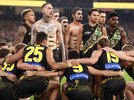
The Laguntas Dance at the Dreamtime game was the public demonstration of Richmond’s club-wide Indigenous transformation
Richmond were about to run onto the MCG for the annual Dreamtime game last Saturday when there was an eruption from Jack Riewoldt.
“They’ve painted themselves up!”
Marlion Pickett
PLAYERCARDSTART
50
Marlion Pickett
- Age
- 32
- Ht
- 184cm
- Wt
- 83kg
- Pos.
- M/F
Career
Season
Last 5
- D
- 13.0
- 3star
- K
- 7.5
- 3star
- HB
- 5.5
- 4star
- M
- 2.4
- 3star
- T
- 3.3
- 5star
- CL
- 1.5
- 4star
- D
- 11.7
- 3star
- K
- 6.7
- 3star
- HB
- 5.0
- 3star
- M
- 2.4
- 3star
- T
- 3.6
- 4star
- CL
- 1.3
- 4star
- D
- 12.8
- 4star
- K
- 7.2
- 3star
- HB
- 5.6
- 4star
- M
- 1.8
- 2star
- T
- 3.2
- 5star
- CL
- 1.6
- 4star
PLAYERCARDEND
PLAYERCARDSTART
44
Sydney Stack
- Age
- 23
- Ht
- 179cm
- Wt
- 75kg
- Pos.
- Def
Career
Season
Last 5
- D
- 15.5
- 4star
- K
- 6.8
- 3star
- HB
- 8.7
- 5star
- M
- 4.1
- 4star
- T
- 3.0
- 5star
- MG
- 202.0
- 3star
- D
- 9.8
- 2star
- K
- 3.4
- 1star
- HB
- 6.4
- 4star
- M
- 1.4
- 2star
- T
- 2.8
- 4star
- MG
- 133.0
- 2star
- D
- 16.2
- 4star
- K
- 7.2
- 3star
- HB
- 9.0
- 5star
- M
- 5.6
- 5star
- T
- 3.0
- 5star
- MG
- 227.4
- 4star
PLAYERCARDEND
PLAYERCARDSTART
37
Matthew Parker
- Age
- 28
- Ht
- 188cm
- Wt
- 80kg
- Pos.
- Fwd
Career
Season
Last 5
- D
- 10.3
- 3star
- K
- 6.8
- 3star
- HB
- 3.6
- 3star
- M
- 2.8
- 3star
- T
- 2.9
- 4star
- G
- 0.9
- 4star
- D
- 6.0
- 1star
- K
- 3.0
- 1star
- HB
- 3.0
- 2star
- M
- 0.0
- 1star
- T
- 1.0
- 2star
- G
- 0.0
- 1star
- D
- 10.4
- 3star
- K
- 6.0
- 3star
- HB
- 4.4
- 4star
- M
- 2.4
- 3star
- T
- 3.8
- 5star
- G
- 0.8
- 4star
PLAYERCARDEND
“We found out at the end of the warm-up,” says Shane Edwards
PLAYERCARDSTART
10
Shane Edwards
- Age
- 35
- Ht
- 182cm
- Wt
- 78kg
- Pos.
- M/F
Career
Season
Last 5
- D
- 17.2
- 4star
- K
- 8.1
- 3star
- HB
- 9.1
- 5star
- M
- 2.6
- 3star
- T
- 2.9
- 4star
- CL
- 3.0
- 4star
- D
- 16.4
- 4star
- K
- 6.6
- 3star
- HB
- 9.8
- 5star
- M
- 0.6
- 1star
- T
- 3.0
- 4star
- CL
- 4.2
- 5star
- D
- 8.6
- 3star
- K
- 5.2
- 2star
- HB
- 3.4
- 3star
- M
- 3.4
- 4star
- T
- 1.2
- 3star
PLAYERCARDEND
“So there was no turning back now.”
The team broke from the national anthem, with its non-Indigenous players forming a huddle for its Indigenous players to emerge from and perform the Laguntas Dance (translated to Tigers Dance in English) they had created.
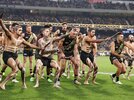
Edwards says the moment crystalised the club’s journey, as well as his own.
“I got here 16 years ago and there was no support for Indigenous players. It was, ‘Get drafted, good luck to you,’” says Edwards. “There’s no way I could have done that when I first came to the club.
“It’s taken so many small steps along the way to get to that point, to have a group of Aboriginal players proud enough to do that in front of so many people is a challenge in itself.
“The coaches completely backed it. To find a segment in the schedule is hard enough, let alone to get the non-Indigenous guys to rehearse when it’s not even their own culture. They’ve obviously taken so much from the Indigenous culture over the years, there were no questions – ‘of course we’re doing it’.
“The symbolism of the Laguntas Dance from where we’d come from as a club. It’s a completely different world.”
In the aftermath, many commentators referred to it being evidence of Richmond now leading the way in reconciliation across the AFL.
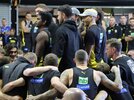
It may never have happened if the Tigers didn’t take the leap to establish its Korin Gamadji Institute more than 15 years ago. Chief Executive Officer Brendon Gale says its effect on the club is immeasurable.
“The KGI has nothing to do with football or producing footballers, it’s about education and enabling the next generation of leaders. But gradually the learnings, the environment and culture that was part of those programs began to wash through the entire club.”
It has changed Richmond forever.

Steven Wright was Gale’s predecessor, and his first impressions of the club were nothing to do with its mediocre playing record.
“I was staggered about how bereft of community focus it was,” Wright says.
“There was so much soul-searching about ourselves and why aren’t we winning games, there was nothing outward-looking.”
A program that engaged local housing estate children was established but a favourite son-turned-rival helped illuminate things for Wright at their Hall of Fame dinner.
“Kevin Sheedy came over and introduced himself. He had an idea to have a game that would celebrate Indigenous culture and thought Richmond and Essendon made sense because of the colours of the Indigenous flag.”
Essendon were seen as the club leading the way so Wright happily followed and Dreamtime at the G was born. Concurrently the Tigers were given the area of Central Australia by the AFL to help develop, leading to a number of visits to remote communities that Wright describes as “life-changing”.
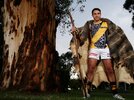
Meanwhile, the facilities at the Tiger home in Punt Road were dilapidated and not conducive to an on-field revival. All of the threads that had marked Wright’s early thoughts on the club came together. The goal would be a new facility with a program for Indigenous youth leadership the centrepiece.
A change of government derailed their initial lobbying efforts, but eventually the Federal Government committed to funding the Richmond vision.
The gravity of what they wanted to achieve hit home for Wright after an interaction with player Alroy Gilligan. He walked into Wright’s office and showed him his family home on Google Earth. It was a tin shack in the middle of the desert.
“Richmond was a club that had Indigenous players come in and they’d be gone a year or two later,” Wright says.
“Here we are expecting these kids to be able to prosper and adjust as well as the private school kid from Melbourne. If you’re late for training by two minutes you get fined $500.”
It was not lost on Aaron Clark, a descendant of the Djab Wurrung people, who was working in the AFL system at the time. Today, he is the Director of the Korin Gamadji Institute.
“For a long time the knock on Aboriginal players was, ‘They’re not resilient’. But these kids were super resilient,” he says.
“They’ve jumped hundreds of hurdles that nobody else has just to get to the starting line.”
Seeing Gilligan’s home solidified Wright’s vision.
“It was such a cultural change. No wonder these kids struggled. We had to create a sense of home at the club.”
Not everyone shared the vision, there were cynics everywhere.
“People at the AFL told me this is beyond Richmond,” Wright says.

Then-Deputy PM Julia Gillard announces the funding for what would become the KGI with Matthew Richardson
PLAYERCARDSTART
Matthew Richardson
- Age
- 49
- Ht
- 195cm
- Wt
- 104kg
- Pos.
- M/F
Career
Season
Last 5
- D
- 14.0
- 4star
- K
- 10.9
- 4star
- HB
- 3.1
- 3star
- M
- 8.0
- 5star
- T
- 0.5
- 3star
No current season stats available
- D
- 15.0
- 4star
- K
- 9.2
- 4star
- HB
- 5.8
- 4star
- M
- 7.8
- 5star
- T
- 0.8
- 3star
PLAYERCARDEND
The AFL’s senior Indigenous executive of the era Jason Mifsud instead had more community-oriented concerns.
“The Victorian Aboriginal community were pretty pissed off that a mainstream institution, let alone an AFL footy club, was awarded $15 million out of an Aboriginal education fund to upgrade their facilities,” he says.
“I remember Andrew Demetriou saying to me, ‘There’s a bit of heat that’s going to come with this, can you work with them on getting it right,’ without really knowing what that meant.”
Clark recalls the angst of the Aboriginal community not knowing anything of the plan before it was announced, while Edwards says the experience for Richmond players didn’t match the ambitions either.
“I saw how hard it was to feel comfortable or adapt quickly enough to what you have to do in this environment before your contract is out. There weren’t even host families for the Indigenous guys, it was just ‘figure it out’.”

Credibility for the project was slowly established when an Indigenous advisory group was set up that included Mifsud, academic Marcia Langton, elder Aunty Joy Murphy Wandin and former Richmond player Phil Egan.
The Tigers then hired their first Indigenous staff member, Luke Murray, who is still at Punt Road 13 years later.
Simon Matthews, who joined from Essendon with the project part of his remit, says it had to be managed carefully.
“We listened. There was clearly discomfort in the community, and we put everything back 12 months because we needed the right people.”

Brendon Gale, CEO, Richmond Football Club with Prime Minister Julia Gillard and her partner Tim Mathieson during the speeches of the Korin Gamadji Institute launch
“Our community has had plenty of new buildings,” Mifsud says. “But it’s the culture and attitude throughout the building that matters.”
The Korin Gamadji Institute was finally opened in August 2011, then-Prime Minister Julia Gillard cutting the ribbon, but Gale admits there were significant growing pains.
“It was pretty tough early, but it gave us a chance to project the broader purpose we’d established at the club – connecting to thrive and win.”
Richmond’s transparency around not claiming to know all the answers and ensuring all the programs were Indigenous-led and designed did earn trust, though.
Angela Burt is a Palawa woman who worked in the KGI and is now Richmond’s Indigenous Player Development Manager. She says the simple act of having her people in the building started to change the dynamic of the club.
“It brought Aboriginal people here and that was a start. People started to feel comfortable, safe and welcome to bring their culture into this place.”
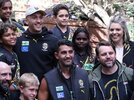
Clark says it worked its way into the playing side of the club and educated a generation of players.
“People forget that in the years KGI started, Riewoldt, Cotchin, Edwards, Astbury, Grimes and Rance spent a ton of time doing community work, anchored with Aboriginal communities” says Clark.
“It was a humbling experience for these young men growing up. Dustin Martin did it too. He’d be talking to kids with difficult upbringings that he could relate to and it was enormous for his growth.”
The case study of Daniel Rioli
PLAYERCARDSTART
17
Daniel Rioli
- Age
- 27
- Ht
- 179cm
- Wt
- 78kg
- Pos.
- Def
Career
Season
Last 5
- D
- 11.2
- 3star
- K
- 5.8
- 2star
- HB
- 5.4
- 4star
- M
- 2.7
- 3star
- T
- 3.2
- 5star
- MG
- 179.2
- 3star
- D
- 8.1
- 2star
- K
- 4.9
- 2star
- HB
- 3.3
- 2star
- M
- 2.0
- 2star
- T
- 2.6
- 4star
- MG
- 144.9
- 3star
- D
- 9.0
- 3star
- K
- 3.8
- 2star
- HB
- 5.2
- 4star
- M
- 0.8
- 1star
- T
- 3.8
- 5star
- MG
- 160.2
- 3star
PLAYERCARDEND
At the same time, the Melbourne Indigenous Transition School was established at the KGI, meaning Year 7 children from all over Australia study as a class for a year before they head off into ‘mainstream’ schooling across Melbourne.
Rioli had participated in various programs at the institute before he was drafted, and with the establishment of the Transition School the club had become a safe and familiar place.
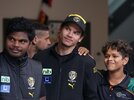
“All of a sudden Daniel has got cousins and family that are here at the club every day,” says Clark.
At the end of 2021, more than 20,000 people had attended the KGI for events, training and programs, and 96 students have graduated from the transition school.
For the last four years Gale has had students from the school live with his family, this year he has two.
“We’ve learned a lot as a family.”
Speak to anyone at Richmond and they say the period that Daniel Rioli
PLAYERCARDSTART
17
Daniel Rioli
- Age
- 27
- Ht
- 179cm
- Wt
- 78kg
- Pos.
- Def
Career
Season
Last 5
- D
- 11.2
- 3star
- K
- 5.8
- 2star
- HB
- 5.4
- 4star
- M
- 2.7
- 3star
- T
- 3.2
- 5star
- MG
- 179.2
- 3star
- D
- 8.1
- 2star
- K
- 4.9
- 2star
- HB
- 3.3
- 2star
- M
- 2.0
- 2star
- T
- 2.6
- 4star
- MG
- 144.9
- 3star
- D
- 9.0
- 3star
- K
- 3.8
- 2star
- HB
- 5.2
- 4star
- M
- 0.8
- 1star
- T
- 3.8
- 5star
- MG
- 160.2
- 3star
PLAYERCARDEND
During a time of on-field strain, Hardwick spent time listening to Rioli’s stories about home and even travelled north with him for a family funeral.
“He participated in some of the ceremonies and saw the power of it,” Clark says. “I think it changed Dimma enormously.”
“Damian is an accountant by trade, he’s got an empirical approach and uses data to explain performance,” Gale says.
He thinks taking in Rioli “helped him shift towards the importance of human connection, understanding and empathy.”
“And he’s become masterful at it.”
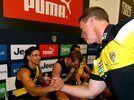
History says 2017 was the start of a Tiger run of three premierships, breaking a 37-year drought and awakening an entire supporter base.
The trademark of that premiership was an approach from players and coach which valued vulnerability. Players would tell their stories and a greater connection was formed.
It’s no coincidence that programs which celebrated Aboriginal storytelling based on this connection were happening in the room down the hallway and its players were already familiar with it. Now they were encouraged to utilise these skills for their on-field endeavours.
“The storytelling gelled the group together,” Edwards confirms.
“We can now draft a Sydney Stack
PLAYERCARDSTART
44
Sydney Stack
- Age
- 23
- Ht
- 179cm
- Wt
- 75kg
- Pos.
- Def
Career
Season
Last 5
- D
- 15.5
- 4star
- K
- 6.8
- 3star
- HB
- 8.7
- 5star
- M
- 4.1
- 4star
- T
- 3.0
- 5star
- MG
- 202.0
- 3star
- D
- 9.8
- 2star
- K
- 3.4
- 1star
- HB
- 6.4
- 4star
- M
- 1.4
- 2star
- T
- 2.8
- 4star
- MG
- 133.0
- 2star
- D
- 16.2
- 4star
- K
- 7.2
- 3star
- HB
- 9.0
- 5star
- M
- 5.6
- 5star
- T
- 3.0
- 5star
- MG
- 227.4
- 4star
PLAYERCARDEND
PLAYERCARDSTART
50
Marlion Pickett
- Age
- 32
- Ht
- 184cm
- Wt
- 83kg
- Pos.
- M/F
Career
Season
Last 5
- D
- 13.0
- 3star
- K
- 7.5
- 3star
- HB
- 5.5
- 4star
- M
- 2.4
- 3star
- T
- 3.3
- 5star
- CL
- 1.5
- 4star
- D
- 11.7
- 3star
- K
- 6.7
- 3star
- HB
- 5.0
- 3star
- M
- 2.4
- 3star
- T
- 3.6
- 4star
- CL
- 1.3
- 4star
- D
- 12.8
- 4star
- K
- 7.2
- 3star
- HB
- 5.6
- 4star
- M
- 1.8
- 2star
- T
- 3.2
- 5star
- CL
- 1.6
- 4star
PLAYERCARDEND
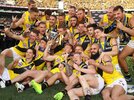
The Richmond Football Club of 2022 is a changed place.
“The culture has impacted every single person here,” says Burt.
Once upon a time it was just Luke Murray, but now on any given day there are more than 50 people studying, working or playing at Punt Road with Indigenous backgrounds. It’s unheard of in any non-Indigenous business, let alone the AFL.
Xavier Clarke is one of the few Indigenous assistant coaches in the league. The clubs claims to have the most diverse playing and staff list in the AFL, and who could argue with that.
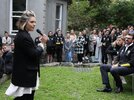
The Laguntas Dance was just a public showing of what Richmond insiders have known for some time.
Watching at home, Wright was moved by the Dreamtime events as he thought back to the original vision.
“When the players stood up in that circle I had a tear in my eye thinking back to people like Shane, but also Richard Tambling
PLAYERCARDSTART
Richard Tambling
- Age
- 37
- Ht
- 180cm
- Wt
- 80kg
- Pos.
- Def
Career
Season
Last 5
- D
- 14.9
- 4star
- K
- 8.4
- 3star
- HB
- 6.5
- 4star
- M
- 4.6
- 4star
- T
- 2.9
- 4star
No current season stats available
- D
- 8.4
- 3star
- K
- 5.6
- 3star
- HB
- 2.8
- 3star
- M
- 3.0
- 3star
- T
- 1.8
- 4star
PLAYERCARDEND
“What’s a club? It‘s meeting together for a common purpose. The professionalism of footy has almost lost the club feeling, so you need to do things that bring people together.”
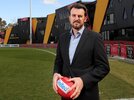
The current club leaders know that all the time invested in the project have been repaid many times over. It has become the signature of Richmond’s resurrection.
“The work the KGI does empowers people to shape their own futures,” Matthews says. “But in doing that it’s shaped our whole club.”
Gale says the establishment of the KGI has been symbolic of a revolution within the club that finally broke the shackles of history into something that values caring over conflict.
“Ruthless Richmond was a badge of honour because it delivered great success. But as the competition grew it wasn’t sustainable,” he says.
“There are fewer opportunities to distinguish yourself as a club in the AFL now. Our commitment to First Australians and reconciliation and how that filters through the club is our culture now.
“We’re a better club.”
When Edwards talks about his pride at last weekend’s Laguntas Dance he could be summing up how everyone at Richmond feels about the 15-year journey.
“I’m just so glad we did it.”



